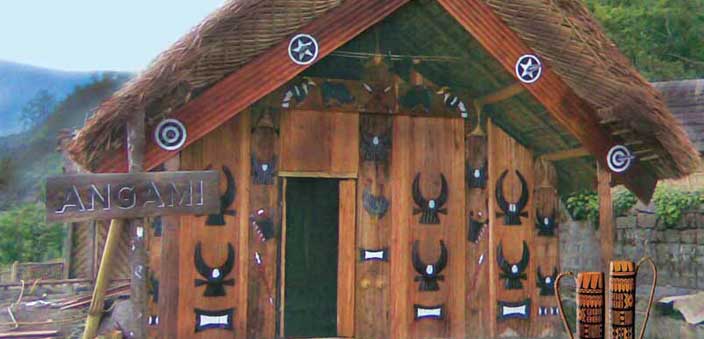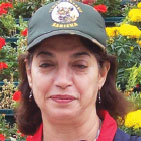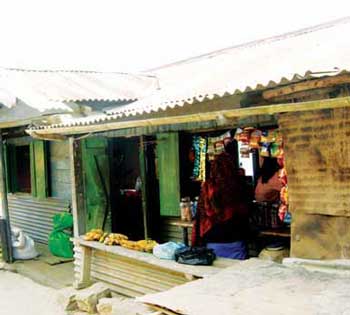
On an evening not long ago, I was dispassionately watching an advertisement for Kaun Banega Corepati, the popular quiz programme. On the set was a young girl from the Northeast, sitting across the show’s host, Amitabh Bachchan. His question to her was: ‘Kohima belongs to which country?’ She looked at him and said she would like to use a lifeline. “Which one?” asked the host. “Audience poll”, replied the young woman. The scene then shifted to a group of people watching the programme on television, who sniggered at this, then shifted back to the set of KBC. Audience poll results come through and it unanimously said ‘India’. Amitabh Bachchan looked at the girl kindly and said, ‘Sat pratishad vote India ko mile hain. Yeh to sabhi jaante hai ki Kohima India mein hai.’ (A hundred percent votes have said Kohima belongs to India and everyone knows this). The girl looked him straight in the eye and asked, ‘Jaante hain, par maante kitne hain?’ (Everyone knows it, but do they accept it?)
Her words made my hair stand on end. Suddenly, I was reliving the trip I had taken to Nagaland, with much trepidation. Nagaland is rife with insurgency and was considered an unsafe destination, as if it is in another hostile land. In spite of severe dissuasion, we took off for Assam and then to Nagaland.
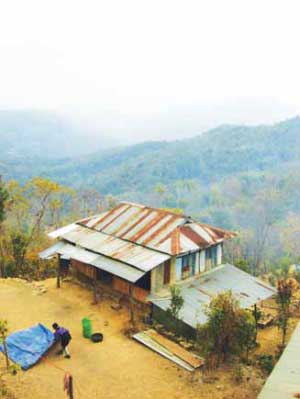
An unconventional welcome
We flew to Assam and from Dibrugarh, Air India took us on a short haul flight to Dimapur at the base of the Naga hills. Dimapur today is an industrial town, but in the 13th century, was the glorious capital of the Kachari kings. The only remains of this vibrant period are the magnificent, megalithic, phallic ruins strewn around the city.
The tiny airport was overly populated with black clad, rifletoting security, but no sense of threat prevailed. Low air-traffic speeded up luggage retrieval and soon we were out on the street, where we encountered more security; we were courteously frisked, papers checked and then escorted to our pre-arranged taxi. It was 2 pm. The sun overhead was bright and hot as we stepped into the waiting cab and began our journey of 74 kms into the hills, headed for the capital city of Nagaland – Kohima.
The road narrowed as we moved out of town, but was smooth. Jungle unfolded on both sides and dwellings were scant, but where they appeared, there were large piles of logged wood stacked by the roadside. The forests were dark green and tinged with brown, awaiting the monsoon, and the hillside was conspicuous by the absence of flowers of any type at all. Not even roadside flowering weeds were visible! As we began to ascend the mountains, the temperature began to drop. The scenery got monotonous, and as there was a total absence of traffic or people, my attention began to wander to all that I had read and heard.
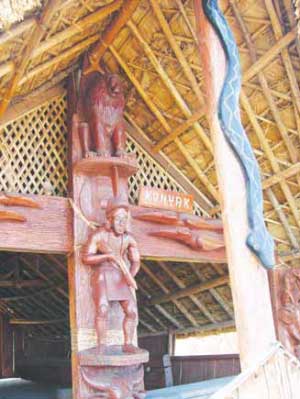
association with snakes, as can be seen with the snake slithering along the pole
The mythological origins
‘Nag’ connotes the world of snakes. In Hinduism and Buddhism, Nagas are semi-divine beings, half human and half serpent, considered to be a strong and handsome race, but also potentially dangerous. They are considered capable of assuming a human, serpent, or half-human and halfserpent form, and are regarded as being superior to humans in several ways.
Mythology relates that the Nagas are the children of Kadru, the granddaughter of the Creator, Brahma, and her husband, Kasyapa. They lived on earth, but multiplied so rapidly that Brahma, fearing for earth, relegated them to the subterranean world. So, they moved beneath the waters and built magnificent jeweled palaces on the bottom of rivers, lakes and seas. Legend has it that their underground realm is patala and they are the guardians of treasure troves. The females or naginis, are serpent princesses of striking beauty and allure. Dynasties of Manipur, a neighbouring state of Nagaland, claim origin in the union of a human being and a nagini and the beauty of the women certainly bear out the legend.
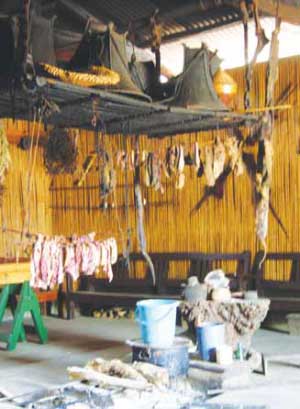
Our epics, the Ramayana and the Mahabharata have references of contact between the Indo-Aryans and people of the Northeast. In ancient Sanskrit literature there is mention of a golden skinned people referred to as Kiritas, who are also mentioned in the Yajurveda and the Atharvaveda, clearly indicating that the Mongoloids were present in this area from ancient times.
The mystery of the Naga past
Naga history is a mystery. No written historical records of their origin or their route of migration to their present location exists. The belief is that the majority of the Nagas migrated from the South-East through the corridor of the Indo-Myanmar border to the Naga Hills. Difficult mountainous terrain, clothed with immense virgin forests, became the haven of several isolated tribes of Indo-Mongol or Myanmarese origins.
Naga scholar Dr. Horam has traced the origin of the Nagas to the Southern seas. He writes: “There can be little doubt that at one time the Nagas must have wandered about before they found this their permanent abode; from their myths and legends one gathers that there is a dim relationship with the natives of Borneo in that the two have a common traditional way of head hunting; with the Indonesians, as both use the loin loom for weaving cloth. The embroidery on the Naga clothes resembled the kind done on Indonesian clothes”.
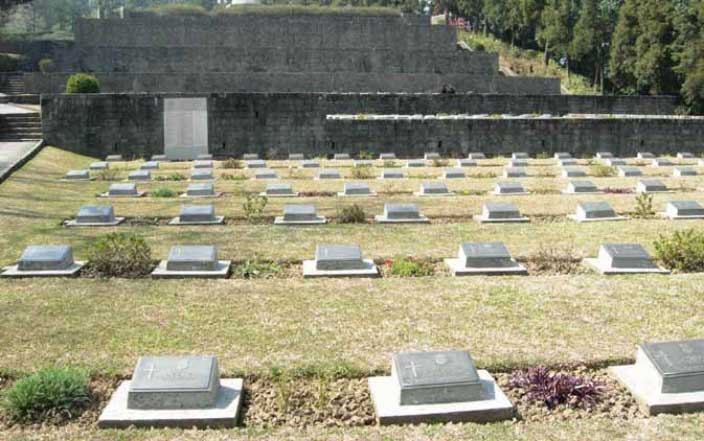
He continues: “The hypothesis that the Nagas must have come from the seacoast or some islands is strengthened by the ornaments still being used today in many Naga villages. Left undisturbed for such a long time, they have retained the culture of the most ancient times till today. Their fondness of cowrie shells as decoration on clothes and the use of conch shells as precious ornaments and the fact that the Nagas have a way of life very similar to that of those living in the remote parts of Borneo, Sarawak, Indonesia and Malaysia are indicative of their original abode by the sea.”
Folklore tells of the Nagas crossing the Indo-Myanmar border to their present location in the Naga Hills. According to folklore, Poumai Naga was an old man who led the Nagas from Myanmar to Shajouba, a village near Makhel, a designated dispersal site. The story goes that when all the tribes had gathered together, Pou thrust his walking stick into the ground and left. The stick took root and soon grew into a wild pear tree that thrives to date in the village of Shajouba, giving veracity to the story. The Nagas consider this wild pear sacred and no one dares to cut any branches from it. If branches shed during a storm, it is seen an ill omen and all 16 tribes propitiate the tree by not working their fields for a day. Not even a twig can be taken from the tree – such is the awe in which it is held.
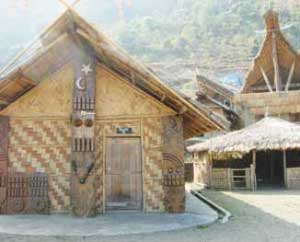
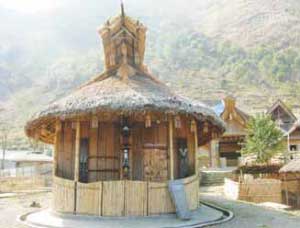
When the pear grew, the Nagas dispersed to various locations in the hills and each tribe named itself after its forefather; the Poumai is named after Pou and Mao after Meo, thus different names like Sema, Lotha, Angami, Ao, Tangkhul and others came into existence and their amalgamation with the local population is perhaps the reason for the numerous dialects generated, each so distinctive that those of another village cannot comprehend it.
The capital city – Kohima
“With 5,000 years of history behind us, it is almost impossible not to have legend put some brush strokes of colour into our lives”, I ruminated, as we sped along the mountain road. Some wayside teahouses began to appear at long intervals; residences by the wayside with a room abutting the road. Members of the family take turns at manning it. Tea is available along with the ubiquitous plastic wrapped snacks!
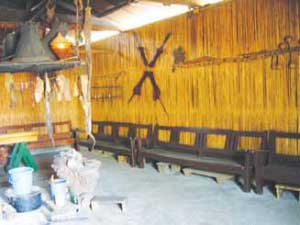
After a three hour drive, when we wound around the mountain and bill boards appeared, I knew we had entered Kohima. It was 5 pm. As we alighted from the car at the entrance to the hotel, I shivered in the frigid evening air. Dimapur was hot when we landed and lulled us into thinking that Kohima would be just pleasantly nippy, but it was bitingly cold, which gave us the impetus to get through the door fast, into the warmth of the interior. Our guide now became our translator, as we stood at the counter, clueless about the language. Although some English is spoken, it is broken and halting, making communication somewhat difficult. Between the receptionist, the guide and us, we managed to complete the formalities of checking in and were escorted to our second floor rooms via the staircase. I was delighted to be in a room with a terrace adjoining it and beautiful, flowering potted plants bordering the walls of the terrace. Standing on the terrace in the bracing cold air, I looked out onto the market and the town beyond. The police headquarters stood out with the flag full mast towering over the market below!
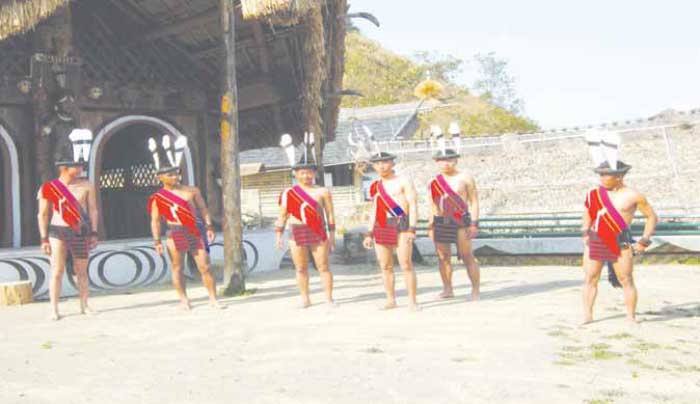
Having freshened up with tea and pakodas, we went downstairs to take a walk in the town. It was 5.30 pm but the sky was gray and tending to black. The town seemed to be engulfed in silence. Our driver, who was in deep in conversation with the shop keeper of the adjoining shop, shot to his feet, like he had seen ghosts! “Going out?” he queried. “Yes”, my husband replied. “We would like to take a turn in the town”. I thought our driver would have a breakdown. We shot each other a bewildered look. “No” he reiterated more forcefully. “All closed now. We go tomorrow”, and barred the way. Left with no choice, we turned and retraced our steps indoors. Back in our room we opened wide the bay window to the terrace and let in the frigid air. Then we took our chairs out on the terrace, set up the heater behind our backs and in silent companionship watched the sky turn to indigo. Stars began to wink and lights to blink in the market below. A scene etched in memory. It was the 14th of February, Valentine’s day, and an evening of perfect celebration!
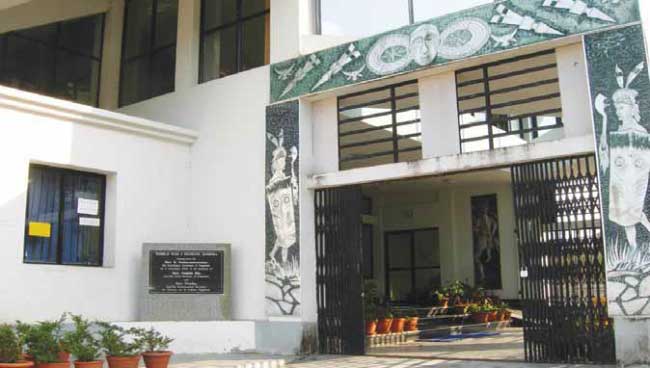
Short summers, long, cold winters
Largely mountainous, Nagaland stretches from southwest to northeast, parallel to the immense valley of the Brahmaputra, the majestic river of Assam. On the other side, Nagaland’s border is defined by the high Himalayas. Mount Saramati is the highest peak of Nagaland at 12,602 feet, in the Twensang district. This is where the Naga Hills merge with the Patkai Range, very close to the border with Myanmar. Mountainous terrain promotes a cool climate. Summer is short in Nagaland and the temperature oscillates between 16 degrees and 31 degrees celsius. Torrential monsoon rains follow the summer and continue practically nonstop from June to September, recording an annual average rainfall from 2000mm- 2500mm. Winter follows immediately on the heels of the rains and temperatures drop further to as low as four degrees celsius. Bitterly cold and dry weather strike parts of the state and the higher altitudes are enveloped in snow.
A range of altitudes and diverse climatic conditions have fostered rich vegetative growth. Evergreen tropical and subtropical forests occupy 20 percent of the state’s total area of 6,410 square miles. Rare species of trees and plants are found in the forests and a variety of endangered species of animals and birds also make the forest regions of Nagaland their home. The Amur Falcon is one such rare bird that migrates through Nagaland. It has one of the longest migration routes among all birds, at 22,000 kms a year from eastern Asia to southern Africa and back. In 2012, wild-lifers unearthed the shocking story of the massacre of tens of thousands of these migratory birds in Nagaland.
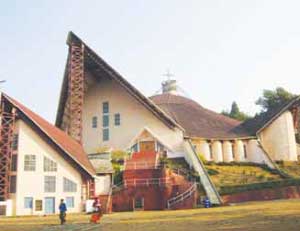
Christians’ in Kohima, combining the architecture of the
traditional church and the Naga hut
Isolated over the centuries, the Naga tribes occupied specific mountain ranges with their settlements on the hilltops, followed animism as a religion and scoured the forest as resource material for all their needs. They fought continuously amongst themselves and resorted to head hunting, until the British arrived. The arrival of the British The British came into contact with the Nagas in 1832 when Captain Jenkins and Pamberton, along with 700 soldiers and 800 porters carrying their baggage and provisions, marched across the Naga Hills in an attempt to find a route from Manipur to Assam, and camped there. The Nagas immediately commenced raiding the British troops in different villages, fighting them continuously until 1880 when the British finally overpowered the Nagas, after which they dominated several parts of the Naga Hills, but the Konyak tribe continued to fight them.
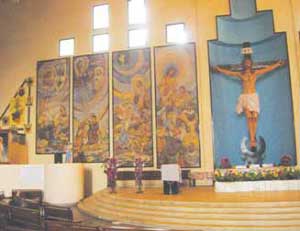
The British followed a policy of “least interference” in the internal affairs of the Nagas, thus, the traditional life pattern of the Naga tribes remained largely unchanged except for some good fallout – the inter-tribal warfare and head-hunting diminished due to British intervention. In the wake of the troops followed the Christian missionaries, and conversions to Christianity followed rapidly. The Japanese invasion and the battle at the tennis court When we left our room and moved out on to the street, both our guide and driver caught up with us. They had the day planned and we were driven straight to the World War II cemetery that occupies centre stage in the city. It was a poignant moment when we entered this sprawling cemetery that occupies a hill, and gazed at the gravestones of all the young men who had fought the Japanese invasion in 1944.
We walked solemnly past the rows of headstones – a total of 1,421 – at each terraced level reading the inscriptions and finally climbed to the very top where a cross has been erected and a plaque mounted in an alcove that reads, ‘Here around the tennis court of the Deputy Commissioner lie the men who fought in the battle of Kohima in which they and their comrades finally halted the invasion of India by the forces of Japan in April 1944’. Lord Earl Mountbatten called this “one of the greatest battles in history…one of naked, unparalleled heroism”.

A moment of truth; cost of freedom is extremely high and we owe a debt to those who paid this price. Pensively I sat by the cross, watching the beautifully laid out and well maintained flowerbeds between the rows of gravestones, far removed from the city, yet in the heart of it.
Nagaland came to the fore during World War II, when India was forced to give troops to the British for their war effort much against its own inclination. Kohima, about 30 miles from the border of Burma, had to be taken by the Japanese if their 1944 ‘U Go’ campaign to capture Delhi was to succeed.
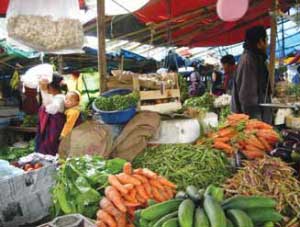
On 15th March, a Japanese division attacked Kohima. They moved swiftly on the city, having reconnoitred the whole area two weeks before the attack. and their work “must rank as one of the most brilliant feats of reconnaissance in the history of war.” British forces in Kohima remained unaware of the advance and learned of it only on 18th March, from fleeing refugees.

The dramatic battle that was to change the tide of the war was fought on the tennis court of the Deputy Commissioner Charles Pawsey’s bungalow, from the 4th of April to 22nd of June, 1944. By 5th April, the British had been forced back onto the Kohima ridge by the speedily advancing Japanese forces. The ridge consisted of Garrison Hill, Jail Hill, Detail Issue Hill and the Deputy Commissioner’s Bungalow, that had now become the main line of defence and was held by the 4th Royal West Kents along with troops from the Assam Rifles and the Assam regiment. Their supply lines cut off, only air drop of food was possible of which a lot fell on the Japanese side.
The Japanese launched a series of attacks into the northeast region of Kohima’s defences. By 9th April, the British and Indian troops were forced out of the Deputy Commissioner’s bungalow to the far end of the tennis court. They came under increasingly heavy artillery and mortar fire and had to repel frequent infantry assaults. It was a scene of some of the hardest, closest and grimmest fighting, with grenades being hurled across the tennis court at point-blank range.
On 15 th April, British troops on Kohima ridge heard that the British 2nd Division was attacking along the Dimapur-Kohima road and had broken through Japanese road blocks.
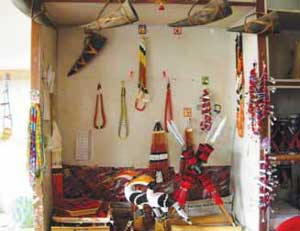
The Naga Heritage Complex and War Museum
After the War Cemetery, we were driven to the Naga Heritage Complex at Kisama, about 12 kms out of Kohima.
Kisama is derived from the names of two villages, Ki(gwema) and (Phe)sama. The suffix ‘Ma’ denotes village. The Naga Heritage complex stands on the land of these two tribes. Outside the cluster of the city, situated on an isolated hill in pristine beauty, it has been created to sustain the distinct identity of dialects, customs and traditions of all the ethnic tribes of Nagaland, showcase it to the outside world, and preserve it for their own, in a rapidly changing scenario.
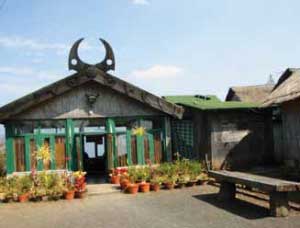
It has the traditional houses of all 16 tribes and the Morung, an all male dormitory, each with its authentic design and indigenous architecture. The now popular Hornbill festival is held here each year and serves to bring all the tribes together in a single arena.
We walked around the complex in leisurely fashion, enjoying the natural surroundings, taking pictures and absorbing the information the guide imparted, explaining all the intricacies of the house design and the symbols that decorated them. Each one was ingeniously built and decorated. They were set well apart with a surrounding compound wall and the artefacts of their daily life contained within. Several huts showcased the living conditions of the Nagas; a central room with a blazing fire and cured meats hanging on hooks. All parts of the animal were hung on hooks above the fire and would be eaten bit by bit through the freezing winter days, when hunting and fresh meat was not possible. The sight was fascinating. When we were through with the houses we walked down the slope to the War Museum.
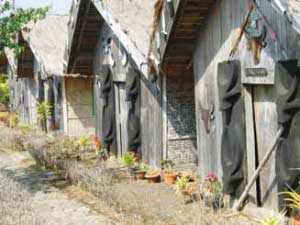
The World War II has left an indelible mark on Kohima, and this may be the reason that most of the young men opt for military service in Nagaland. At the base of the Heritage Village complex is the newly opened War Museum. A general and his entourage were visiting the museum with the curator in close attendance and attention and we were totally neglected by the staff! Nagas are generally aloof from visitors but courteous when spoken to. The general went around and reminisced about the battle to those around him, recounting what position he, along with his men had held during the battle. Later, the Phoem tribe, from which his men were probably drawn, were to perform for him at the Phoem hut. We were very fortunate to see the tribe, dressed in their ceremonial best, await their general.
A large Cathedral and the tallest wooden cross
As we left the Heritage complex, morning had merged into afternoon. We headed back into town and went on to Aradura hill, where the largest Cathedral of northeast India is located. It was the most unusual edifice I have ever seen blending the traditional with the indigenous. It houses a cross 16 feet high, the largest wooden cross in the country and probably the tallest in all of Asia.
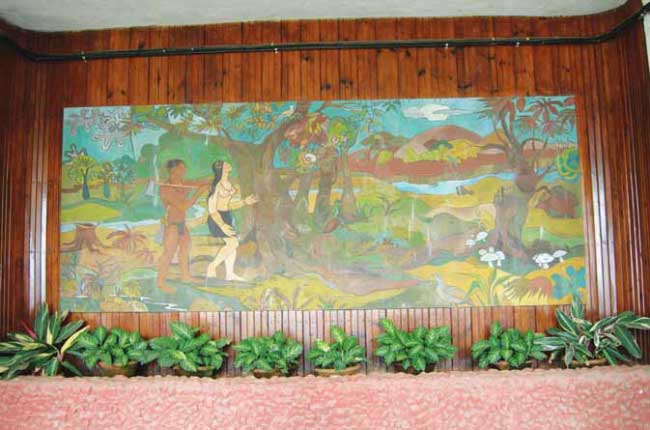
The Cathedral owes its existence to Lieutenant Reverend Abraham Alnagimttathil, the first bishop of Nagaland, who envisioned a place for prayer in peace and solitude. Work began on the building in 1986 with a large part of the finance coming from the Japanese, who lost thousands in the battle at Kohima. The church of ‘Mary Help of the Christians’ was consecrated in 1991.
All about Naga shawls, squirmy worms and hot chilli paste
Next morning, we meandered through the typically narrow hill streets with shops lining them. I was keen on buying Naga scarves and shawls with their fascinating colours and patterns and was told that each particular colour combination and pattern is a tribal stamp. Colours are different for men and women. “Take what you like”, says a person next to me, “it will make no difference to you, but for us they are a stamp of our identity”. The jewellery of the Nagas is beads strung in ways that mark their tribal distinctions.
Shopping over, we moved on and came upon a vibrant market, sprawling by the side of the road and dropping down to lower levels on the hill slopes, negotiated by roughly cut stairs. The base level is the heart of the market, with highly interesting fare like woodworms squirming in a plastic basin. “Very tasty, try”, says the vendor, “How much?” I ask. I don’t know at that point, what was more horrifying for me, the idea of paying `1,000 for a few squiggles in motion or eating them! But I happily photographed them. The market was a riot of colours with loads of vegetables that one does not see in the plains.
Nagas are reputed to eat anything that moves, so wood worms or kellu, hornet grubs, grasshoppers, fermented fish and pork and even dog meat is the local fare, cooked with a very hot chilli paste. Meats and fish are fermented or smoked over the home fire to preserve them, and during the harsh winters small bits are cut and cooked with the King chilli, reputed to be the hottest chilli in the world. Fortunately, hotels will also serve chicken, pork or beef. The closest I got to Naga food was to have the Tenga chicken, which was a watery chilli curry with bamboo shoots and pieces of chicken in it. Some other interesting places to visit are the state museum, provided there is electricity when you get there, and the Touphema Tourist village, about 41 kilometers from Kohima. Located on a hillock, with a valley view, this complex offers a taste of the Naga lifestyle. The village has a cluster of theme based huts with modern interiors, while the outer façade is authentically traditional.
It is very clear that it is difficult to halt the wave of change. Isolated and left to themselves the Nagas lived their ancient lifestyle for centuries. Exposed to modernity, they are helpless against its onslaught, now sweeping away an ancient way of life that had endured over the centuries.

